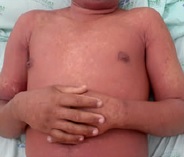Drug rash with eosinophilia and systemic symptoms syndrome induced by carbamazepine: Case report
Abstract
Drug rash with eosinophilia and systemic symptoms (DRESS) syndrome is a hypersensitivity reaction associated with a variety of drugs, mainly anticonvulsants, which is characterized by systemic symptoms and erythematous lesions, common to other toxicodermas. It is an uncommon clinical entity that requires a high suspicion by clinical staff given its varied initial presentation, and the fact that symptoms can overlap with those of other adverse cutaneous reactions to drugs. Without early diagnosis and appropriate treatment, mortality increases.
We report the case of a 22-year-old patient with impaired neurodevelopment who received treatment with carbamazepine. Two months later he presented with general symptoms and skin erythematous lesions that began on his trunk. The patient received outpatient care with antihistamines and antipyretics without an appropriate response. His case progressed with increased skin lesions and systemic symptoms that met the diagnostic criteria for DRESS syndrome. He was hospitalized and received medical treatment according to recommended guidelines. The patient’s condition improved as his symptoms and associated complications resolved. He was discharged with gradual clearing of the steroid therapy.
Downloads
References
Magliano J, Álvarez M, Salmentón M. Síndrome DRESS por carbamazepina. Arch Pediatr Urug. 2009;80:291-5.
Castagnino J, Musella R, Palmero D. Síndrome DRESS inducido por fármacos antituberculosis. Revista Americana de Medicina Respiratoria. 2011;3:141-6.
Sánchez X, Merlano C, Cruz C. Síndrome de hipersensibilidad a medicamentos con eosinofilia y síntomas sistémicos DRESS. Rev Asoc Colomb Dermatol. 2008;16: 208-10.
David P, Lackington I, Naranjo V, Oporto S, Leal C, Mena A. Actualización y presentación de serie clínica de síndrome de hipersensibilidad a fármacos anticonvulsivantes aromáticos o DRESS. Revista Chilena de Epilepsia. 2013;3:25-37.
Muciño J, Díaz M, Briones C, Guerrero A, Sandoval O, Sáenz A, et al. Síndrome de DRESS reporte de un caso clínico. Rev Med Inst Mex Seguro Soc. 2013;51:330-5.
Grando L, Berger T, Marchiori R. Severe cutaneous reactions to drugs in the setting of a general hospital. An Bras Dermatol. 2014;89:758-62. http://dx.doi.org/10.1590/abd1806-4841.20142997
Cormack M, Alfirevic A, Bourgeois S, Farrell J, Kasperaviciute D, Carrington M, et al. HLA-A 3101 and carbamazepine-induced hypersensitivity reactions in Europeans. N Engl J Med. 2011;364:1134-43. http://dx.doi.org/10.1056/NEJMoa1013297
Stern RS. Exanthematous drug eruptions. N Engl J Med. 2012;366:2492-250. http://dx.doi.org/10.1056/NEJMcp1104080
Felgueiras P, Guerreiro E, Pereira E, López R. Síndrome de DRESS. Galicia Clin. 2011;72:185-7.
Valderrama F, Montoya L. Síndrome de hipersensibilidad a los anticonvulsivos. Rev Colomb Psiquiat. 2014;43:225-8.
Cacoub P, Musette P, Descamps V, Meyer O, Speirs C, Finzi L, et al. The DRESS syndrome: A literature review. Am J Med. 2011;124:588-97. http://dx.doi.org/10.1016/j.amjmed.2011.01.017
Rojas C, Méndez L, Arab J, Barrera F, Soza A, Nervi F, et al. Síndrome de DRESS. Eritema cutáneo, fiebre y hepatitis asociado a lamotrigina. Reporte de dos casos y revisión de literatura. Rev Gastroenterol Latinoam. 2010;21:357-62.
Ríos J, Ríos M. El concepto P-I: una nueva teoría inmunológica sobre las reacciones cutáneas asociadas a fármacos. Rev Méd Cient. 2011;24:20-32.
Quintero D, Flores R, Torres L. Síndrome de DRESS asociado con carbamazepina. Bol Med Hosp Infant Mex. 2015;72:118-23. http://dx.doi.org/10.1016/j.bmhimx.2015.03.007
Ahluwalia J, Arkin L, Boos M, Dunn M, Treat J. Peripheral bands in the setting of drug hypersensitivity syndrome. J Am Acad Dermatol. 2014;71:e153-4. http://dx.doi.org/10.1016/j.jaad.2014.06.007
Hsiao YH, Hui RC, Wu T, Chang WC, Hsih MS3, Yang CH, et al. Genotype-phenotype association between HLA and carbamazepine-induced hypersensitivity reactions: Strength and clinical correlations. J Dermatol Sci. 2014;73:101-9. http://dx.doi.org/10.1016/j.jdermsci.2013.10.003
Torres M, Olmos E. Reacciones medicamentosas severas- Síndrome Stevens Johnson y síndrome DRESS. Acta Med Colomb. 2013;38:76-82.
Hanafusa T, Azukizawa H, Matsumura S, Katayama I. The predominant drug-specific T-cell population may switch from cytotoxic T cells to regulatory T cells during the course of anticonvulsant-induced hypersensitivity. J Dermatol Sci. 2012;65:213-9. http://dx.doi.org/10.1016/j.jdermsci.2011.12.002
Niu J, Jia Q, Ni Q, Yang Y, Chen G, Yang X, et al. Association of CD8+ T lymphocyte repertoire spreading with the severity of DRESS syndrome. Sci Rep. 2015;5:9913.
http://dx.doi.org/10.1038/srep09913
Nguyen DV, Chu HC, Nguyen DV, Phan MH, Craig T, Baumgart K, et al. HLA-B*1502 and carbamazepineinduced severe cutaneous adverse drug reactions in Vietnamese. Asia Pac Allergy. 2015;5:68-77. http://dx.doi.org/10.5415/apallergy.2015.5.2.68
Cheng CY, Su SC, Chen CH, Chen WL, Deng ST, Chung WH. HLA associations and clinical implications in t-cell mediated drug hypersensitivity reactions: An updated review. J Immunol Res. 2014;2014:565320. http://dx.doi.org/10.1155/2014/565320
Patiño A, Echeverry T, de la Cruz G, Guerra NT, Murcia LM, Aldana C. Reacciones cutáneas severas a medicamentos. DRESS y sulfasalazina. Acta Med Colomb. 2012;37:83-8.
Ogawa K, Morito H, Hasegawa A, Daikoku N, Miyagawa F, Okazaki A, et al. Identification of thymus and activationregulated chemokine (TARC/CCL17) as a potential marker for early indication of disease and prediction of disease activity in drug-induced hypersensitivity syndrome (DIHS)/drug rash with eosinophilia and systemic symptoms (DRESS). J Dermatol Sci. 2013;69:38-43. http://dx.doi.org/10.1016/j.jdermsci.2012.10.002

| Article metrics | |
|---|---|
| Abstract views | |
| Galley vies | |
| PDF Views | |
| HTML views | |
| Other views | |

























